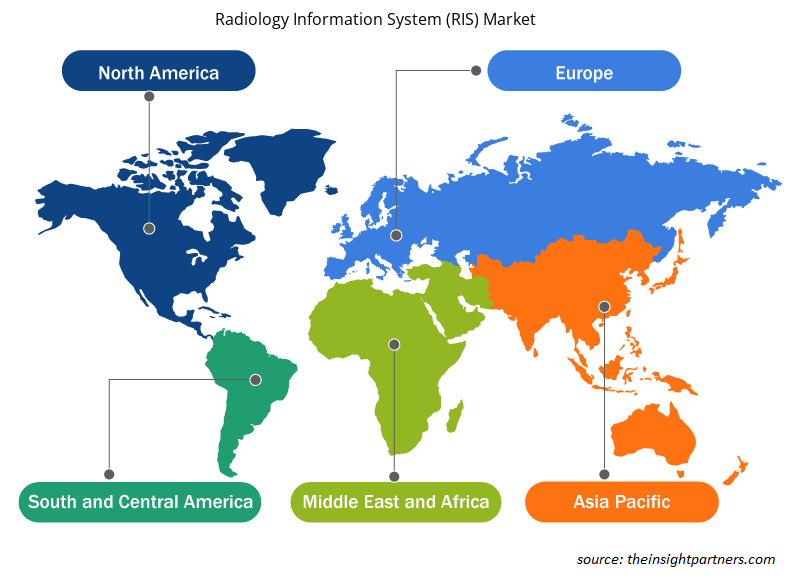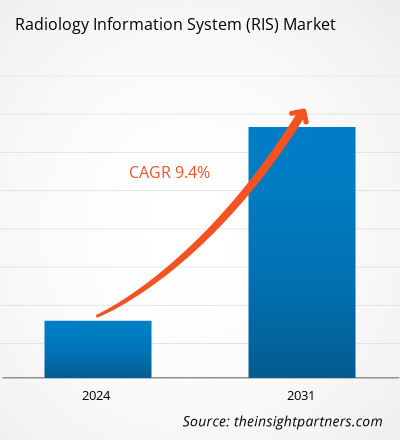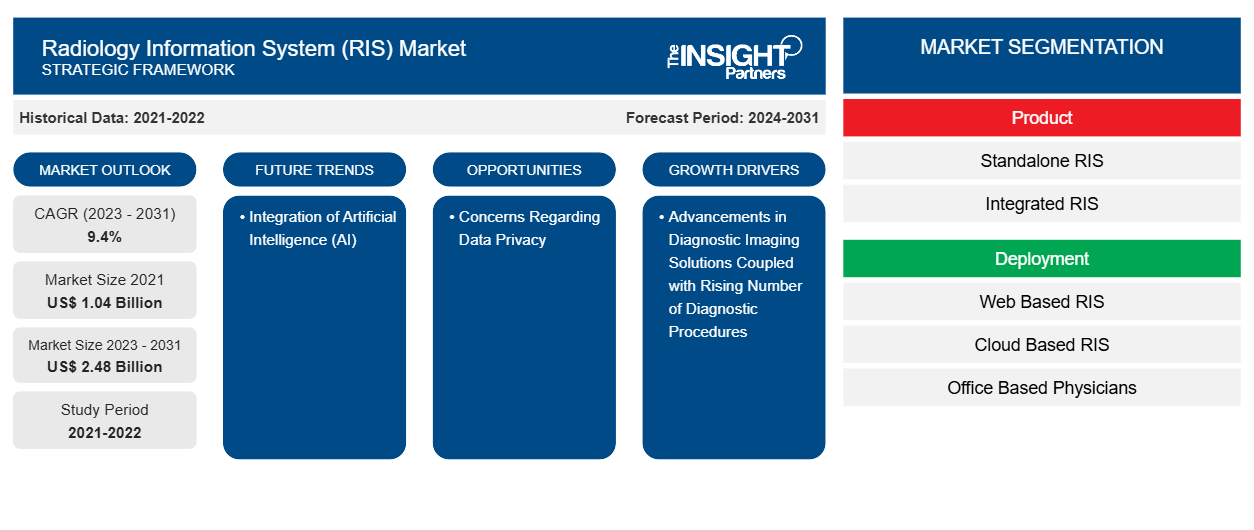بلغ حجم سوق نظام معلومات الأشعة (RIS) في عام 2021 1.04 مليار دولار أمريكي ومن المتوقع أن يصل إلى 2.48 مليار دولار أمريكي بحلول عام 2031 من XX مليار دولار أمريكي في عام 2023. ومن المتوقع أن يسجل السوق معدل نمو سنوي مركب بنسبة 9.4٪ في الفترة 2023-2031. ومن المرجح أن يظل الوعي المتزايد بشأن نظام معلومات الأشعة (RIS) مع مخاطره الصحية الأقل ومعدل اعتماده في المناطق النامية من الاتجاهات الرئيسية لسوق نظام معلومات الأشعة (RIS).
تحليل سوق نظام معلومات الأشعة (RIS)
تشمل عوامل نمو السوق الرئيسية زيادة معدلات الإصابة بالأمراض المزمنة، والوصول إلى أنظمة تكنولوجيا المعلومات للرعاية الصحية، والتمويل الحكومي لأبحاث السرطان. علاوة على ذلك، فإن عبء الأمراض المزمنة يتزايد في جميع أنحاء العالم، إلى جانب زيادة شيخوخة السكان، والاضطرابات المرتبطة بأسلوب الحياة مثل السرطان والتهاب المفاصل وأمراض القلب والأوعية الدموية والسكري هي بعض العوامل الرئيسية المسؤولة عن نمو هذا السوق. ومن المتوقع أن تؤدي الزيادة في حالات الإصابة بالسرطان إلى التركيز المتزايد على خدمات الأشعة للتشخيص المناسب، ومن المتوقع أن يؤدي ذلك إلى زيادة الطلب على أنظمة معلومات الأشعة. تعمل الأمراض المزمنة المتزايدة مثل السرطان على تعزيز الطلب على أنظمة معلومات الأشعة. ومع ذلك، من المتوقع أن تعيق تكلفة التثبيت العالية ونقص العمالة الماهرة نمو السوق خلال فترة الدراسة.
نظرة عامة على سوق نظام معلومات الأشعة (RIS)
RIS هو برنامج متخصص في الرعاية الصحية مصمم لإدارة وتبسيط عمليات مراكز الأشعة والتصوير. يخزن RIS ويدير ويوزع الصور الإشعاعية ومعلومات المرضى والبيانات ذات الصلة. ستعمل التطورات التكنولوجية المستمرة، بما في ذلك التعلم الآلي والتعلم العميق وتكامل الذكاء الاصطناعي في الرعاية الصحية، على تحسين دقة وكفاءة أنظمة الأشعة. بالإضافة إلى ذلك، فإن الطلب المتزايد على حلول الرعاية الصحية المتكاملة لتحسين رعاية المرضى وتبسيط سير العمل يؤدي إلى اعتماد RIS. تعمل اللوائح والمبادرات الحكومية أيضًا على تعزيز توحيد البيانات والسجلات الطبية. كما أنها توفر حوافز لتبني خدمات تكنولوجيا المعلومات للرعاية الصحية، والتي من المتوقع أن تؤثر بشكل إيجابي على فرص نمو السوق.
قم بتخصيص هذا التقرير ليناسب متطلباتك
ستحصل على تخصيص لأي تقرير - مجانًا - بما في ذلك أجزاء من هذا التقرير، أو تحليل على مستوى الدولة، وحزمة بيانات Excel، بالإضافة إلى الاستفادة من العروض والخصومات الرائعة للشركات الناشئة والجامعات
-
احصل على أهم اتجاهات السوق الرئيسية لهذا التقرير.ستتضمن هذه العينة المجانية تحليلاً للبيانات، بدءًا من اتجاهات السوق وحتى التقديرات والتوقعات.
محركات وفرص سوق نظام معلومات الأشعة (RIS)
التطورات في حلول التصوير التشخيصي لصالح السوق
لقد أدى إدخال التصوير الرقمي إلى تحويل مجال الأشعة. فقد حفز الانتقال من التصوير التقليدي القائم على الأفلام إلى التنسيقات الرقمية، وتحسين إدارة البيانات، وزيادة إمكانية الوصول. كما أدت معالجة الصور الرقمية إلى تحسينات كبيرة في جودة الصورة. يسمح نظام معالجة الصور الرقمية لموظفي الرعاية الصحية بتحديد مواعيد للأفراد على أساس المرضى الداخليين والخارجيين. لقد تقدم علم الأشعة نحو الإدارة المحوسبة في الخدمة الصحية واستجاب للطلب على الاتصال السريع والفعال من حيث التكلفة بين أقسام الأشعة ومستخدميها. في السنوات القليلة الماضية، كانت هناك تطورات مختلفة في وسائل التصوير داخل الرعاية الصحية لأغراض التشخيص. في السنوات الأخيرة، تم إحراز العديد من التطورات في التصوير الشعاعي الرقمي ، بما في ذلك تفسير الأشعة السينية بمساعدة الذكاء الاصطناعي، والتصوير ثنائي الطاقة، والتصوير المقطعي، والتشخيص بمساعدة الكمبيوتر، وخياطة الصور التلقائية، والتصوير الشعاعي الرقمي المتنقل. وقد أدت هذه التطورات إلى تحسين جودة الصورة، مما يساعد على تحسين رعاية المرضى وتحقيق نتائج أفضل للمرضى. بالإضافة إلى ذلك، يقلل استخدام التصوير الشعاعي الرقمي من الحاجة إلى تكرار التصوير، والذي يتميز بميزة التعرض الأقل للإشعاع.
التبني المتزايد لخدمات تكنولوجيا المعلومات في مجال الرعاية الصحية في الاقتصادات الناشئة – فرصة لنمو سوق أنظمة معلومات الأشعة (RIS)
على الصعيد العالمي، هناك حاجة متزايدة لتبني التكنولوجيا في خدمات الأشعة لتلبية المطالب. ويكمن مستقبل RIS في استخدام الذكاء الاصطناعي (AI) والتعلم الآلي (ML). يمكن أن تساعد خوارزميات الذكاء الاصطناعي أخصائيي الأشعة في تحليل الصور واكتشاف التشوهات ودعم القرارات. يمكن لخوارزميات التعلم الآلي التعلم باستمرار من كميات هائلة من البيانات وتحسين التشخيصات وخطط العلاج. يمكن أن يؤدي تحسين الاتصال من خلال الإنترنت وتكنولوجيا الهاتف المحمول، والأشعة عن بعد، والذكاء الاصطناعي، والتطورات في معلومات التصوير الطبي، وأجهزة التصوير الطبي المحمولة أو المتنقلة إلى تمكين المواقع النائية في أي بلد من الوصول إلى رعاية صحية وتشخيصات أفضل. علاوة على ذلك، في البلدان النامية، أصبحت أنظمة الرعاية الصحية أكثر ملاءمة للتكنولوجيا حيث تشهد البلدان تدويل الرعاية كعلامات تجارية راسخة. على سبيل المثال، وسعت عيادة كليفلاند التي تتخذ من الولايات المتحدة مقراً لها أسواقها في الإمارات العربية المتحدة، ودخلت شركة Babylon الناشئة التي تتخذ من إنجلترا مقراً لها، وهي تطبيق تشخيصي للرعاية الأولية مدعوم بالتعلم الآلي والذكاء الاصطناعي، إلى الصين ورواندا.
تقرير تحليل تجزئة سوق نظام معلومات الأشعة (RIS)
إن القطاعات الرئيسية التي ساهمت في اشتقاق تحليل سوق نظام معلومات الأشعة (RIS) هي المنتج والنشر والمكونات والمستخدم النهائي.
- بناءً على المنتج، ينقسم سوق نظام معلومات الأشعة (RIS) إلى نظام معلومات الأشعة المستقل ونظام معلومات الأشعة المتكامل. في عام 2023، استحوذ قطاع نظام معلومات الأشعة المتكامل على أكبر حصة في السوق، ومن المتوقع أن يسجل نفس القطاع أعلى معدل نمو سنوي مركب خلال فترة التوقعات.
- من حيث النشر، يتم تقسيم السوق إلى RIS المستندة إلى الويب، وRIS المستندة إلى السحابة، وRIS المحلية. في عام 2023، استحوذت شريحة RIS المستندة إلى الويب على أكبر حصة من السوق. ومع ذلك، من المتوقع أن تسجل شريحة RIS المستندة إلى السحابة أعلى معدل نمو سنوي مركب خلال الفترة 2023-2031.
- بناءً على المكون، يتم تصنيف سوق نظام معلومات الأشعة (RIS) إلى أجهزة وبرامج وخدمات. في عام 2023، استحوذ قطاع الخدمات على أكبر حصة في السوق، ومن المتوقع أن يسجل قطاع البرامج أعلى معدل نمو سنوي مركب خلال فترة التنبؤ.
- من حيث المستخدم النهائي، يتم تقسيم السوق إلى أطباء المكاتب والمستشفيات ومقدمي خدمات الطوارئ الصحية. في عام 2023، استحوذ قطاع المستشفيات على أكبر حصة من السوق، ومن المتوقع أن يسجل نفس القطاع أعلى معدل نمو سنوي مركب خلال الفترة المتوقعة.
تحليل حصة سوق نظام معلومات الأشعة (RIS) حسب المنطقة الجغرافية
ينقسم النطاق الجغرافي لتقرير سوق نظام معلومات الأشعة (RIS) بشكل أساسي إلى خمس مناطق: أمريكا الشمالية، وآسيا والمحيط الهادئ، وأوروبا، والشرق الأوسط وأفريقيا، وأمريكا الجنوبية/أمريكا الجنوبية والوسطى.
لقد هيمنت أمريكا الشمالية على سوق نظام معلومات الأشعة (RIS). ومن المتوقع أن يشهد الطلب على السوق في المنطقة نموًا بمعدل كبير بسبب عدة عوامل مثل الاستثمار الحكومي في البنية التحتية للرعاية الصحية، وزيادة الوعي فيما يتعلق بالتصوير الطبي بالإضافة إلى الفوائد المرتبطة بتنفيذ RIS. في الولايات المتحدة، تعد عوامل مثل العدد الكبير من مراكز التصوير في هذه المنطقة، والوتيرة السريعة للتقدم التكنولوجي، وتزايد عدد السكان المسنين والطلب المتزايد على التشخيص بمساعدة الكمبيوتر، من بين محركات النمو الرئيسية لهذا السوق. كما من المتوقع أن يوفر وجود العديد من الشركات العاملة في تطوير أنظمة متقدمة من RIS للتصوير التشخيصي لأمراض القلب والأوعية الدموية والعظام والأسنان والأورام فرص نمو لنمو السوق. ومع ذلك، من المتوقع أن تنمو منطقة آسيا والمحيط الهادئ بأعلى معدل نمو سنوي مركب في السنوات القادمة بسبب عوامل مثل نمو صناعة تكنولوجيا المعلومات الصحية في هذه المنطقة بسبب تحسين البنية التحتية للرعاية الصحية وارتفاع معدل تبني تقنيات الرعاية الصحية المتقدمة من قبل المستهلكين.
رؤى إقليمية حول سوق نظام معلومات الأشعة (RIS)
لقد قام المحللون في Insight Partners بشرح الاتجاهات والعوامل الإقليمية المؤثرة على سوق نظام معلومات الأشعة (RIS) طوال فترة التنبؤ بشكل شامل. يناقش هذا القسم أيضًا قطاعات سوق نظام معلومات الأشعة (RIS) والجغرافيا في جميع أنحاء أمريكا الشمالية وأوروبا ومنطقة آسيا والمحيط الهادئ والشرق الأوسط وأفريقيا وأمريكا الجنوبية والوسطى.

- احصل على البيانات الإقليمية المحددة لسوق نظام معلومات الأشعة (RIS)
نطاق تقرير سوق نظام معلومات الأشعة (RIS)
| سمة التقرير | تفاصيل |
|---|---|
| حجم السوق في عام 2021 | 1.04 مليار دولار أمريكي |
| حجم السوق بحلول عام 2031 | 2.48 مليار دولار أمريكي |
| معدل النمو السنوي المركب العالمي (2023 - 2031) | 9.4% |
| البيانات التاريخية | 2021-2022 |
| فترة التنبؤ | 2024-2031 |
| القطاعات المغطاة |
حسب المنتج
|
| المناطق والدول المغطاة |
أمريكا الشمالية
|
| قادة السوق وملفات تعريف الشركات الرئيسية |
|
كثافة اللاعبين في سوق نظام معلومات الأشعة (RIS): فهم تأثيره على ديناميكيات الأعمال
يشهد سوق نظام معلومات الأشعة (RIS) نموًا سريعًا، مدفوعًا بالطلب المتزايد من المستخدم النهائي بسبب عوامل مثل تفضيلات المستهلك المتطورة والتقدم التكنولوجي والوعي المتزايد بفوائد المنتج. ومع ارتفاع الطلب، تعمل الشركات على توسيع عروضها والابتكار لتلبية احتياجات المستهلكين والاستفادة من الاتجاهات الناشئة، مما يؤدي إلى زيادة نمو السوق.
تشير كثافة اللاعبين في السوق إلى توزيع الشركات أو المؤسسات العاملة في سوق أو صناعة معينة. وهي تشير إلى عدد المنافسين (اللاعبين في السوق) الموجودين في مساحة سوق معينة نسبة إلى حجمها أو قيمتها السوقية الإجمالية.
الشركات الرئيسية العاملة في سوق نظام معلومات الأشعة (RIS) هي:
- شركة كونيكليكي فيليبس إن في،
- شركة سيمنز هيلثينيرز ايه جي،
- شركة باير ايه جي،
- شركة سيرنر،
- شركة جنرال الكتريك
- شركة ماكيسون،
إخلاء المسؤولية : الشركات المذكورة أعلاه ليست مرتبة بأي ترتيب معين.

- احصل على نظرة عامة على أهم اللاعبين الرئيسيين في سوق نظام معلومات الأشعة (RIS)
أخبار السوق والتطورات الأخيرة في مجال نظام معلومات الأشعة (RIS)
يتم تقييم سوق نظام معلومات الأشعة (RIS) من خلال جمع البيانات النوعية والكمية بعد البحث الأولي والثانوي، والذي يتضمن منشورات الشركات المهمة وبيانات الجمعيات وقواعد البيانات. فيما يلي قائمة بالتطورات في سوق نظام معلومات الأشعة (RIS):
- يسر مجموعة رويال سوليوشنز، وهي شركة رائدة في مجال توفير برامج الرعاية الصحية، أن تعلن عن توسيع شراكتها مع شركة كونكورد تكنولوجيز. يتيح دمج التكنولوجيا الإضافية من مجموعة حلول معالجة البيانات المتطورة Practical AI من شركة كونكورد مسح الملاحظات المطبوعة والمكتوبة بخط اليد بسهولة، ثم استخراج البيانات ودمجها في سير العمل. يعد هذا بتحويل الطريقة التي تتعامل بها الممارسات الطبية مع إدخال الطلبات والفهرسة والموافقة المسبقة. من خلال أتمتة هذه العمليات الحرجة، يتم تمكين المتخصصين في الرعاية الصحية من التركيز على رعاية المرضى بدلاً من الأعمال الورقية. (مجموعة رويال سوليوشنز، ذ.م.م، بيان صحفي، 2024)
- أبرمت مستشفيات مانيبال، إحدى أبرز مقدمي الرعاية الصحية في الهند، اتفاقية مع شركة فوجيفيلم الهند. وبموجب الاتفاقية طويلة الأجل، سيتم تزويد مستشفيات مانيبال بنظام أرشفة الصور والاتصالات واسع النطاق (PACS)، مدعوم من شركة فوجيفيلم الهند. يلغي نظام PACS الحاجة إلى تخزين واسترجاع وإرسال المعلومات الحساسة والأفلام والتقارير يدويًا. (FUJIFILM India Private Limited، أخبار، 2023)
- استحوذت شركة PARATUS على حصة الأغلبية في شركة IMAGE Information Systems. تعد شركة IMAGE من الشركات الرائدة في توفير أنظمة PACS التي تخدم مراكز التصوير والمستشفيات في جميع أنحاء العالم. يعد هذا الاستثمار من قبل شركة PARATUS حجر أساس استراتيجي في إنشاء شركة رائدة عالميًا في مجال توفير برامج الرعاية الصحية وخدمات تكنولوجيا المعلومات. (RADiQ IMAGE Information Systems، أخبار، 2023)
- أطلقت شركة فيليبس حلول معلوماتية جديدة معززة بالذكاء الاصطناعي لزيادة الثقة التشخيصية من خلال الذكاء في كل خطوة من خطوات سير عمل الأشعة في الجمعية الملكية لطب الأشعة في أمريكا الشمالية. (Koninklijke Philips NV، الأخبار، 2022)
تقرير سوق نظام معلومات الأشعة (RIS) والتغطية والنتائج المتوقعة
يوفر تقرير "حجم سوق نظام معلومات الأشعة (RIS) والتوقعات (2021-2031)" تحليلاً مفصلاً للسوق يغطي المجالات التالية:
- حجم السوق والتوقعات على المستويات العالمية والإقليمية والوطنية لجميع قطاعات السوق الرئيسية التي يغطيها النطاق
- ديناميكيات السوق مثل المحركات والقيود والفرص الرئيسية
- الاتجاهات المستقبلية الرئيسية
- تحليل مفصل لقوى PEST/Porter الخمس وSWOT
- تحليل السوق العالمي والإقليمي الذي يغطي اتجاهات السوق الرئيسية واللاعبين الرئيسيين واللوائح والتطورات الأخيرة في السوق
- تحليل المشهد الصناعي والمنافسة الذي يغطي تركيز السوق، وتحليل خريطة الحرارة، واللاعبين البارزين، والتطورات الأخيرة
- ملفات تعريف الشركة التفصيلية
- التحليل التاريخي (سنتان)، سنة الأساس، التوقعات (7 سنوات) مع معدل النمو السنوي المركب
- تحليل PEST و SWOT
- حجم السوق والقيمة / الحجم - عالمي، إقليمي، بلد
- الصناعة والمنافسة
- مجموعة بيانات إكسل
التقارير الحديثة
شهادات العملاء
سبب الشراء
- اتخاذ قرارات مدروسة
- فهم ديناميكيات السوق
- تحليل المنافسة
- رؤى العملاء
- توقعات السوق
- تخفيف المخاطر
- التخطيط الاستراتيجي
- مبررات الاستثمار
- تحديد الأسواق الناشئة
- تحسين استراتيجيات التسويق
- تعزيز الكفاءة التشغيلية
- مواكبة التوجهات التنظيمية























 احصل على عينة مجانية ل - سوق نظام معلومات الأشعة (RIS)
احصل على عينة مجانية ل - سوق نظام معلومات الأشعة (RIS)